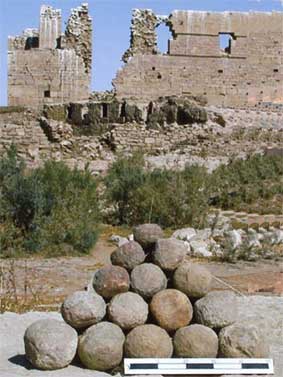|
"The Ethiopians who extend towards
the south and Meroe are not many in number and are a scattered population
because they inhabit a long, narrow, winding river bank. They are
not well prepared for warfare or for any other kind of life."
(Strabo 17.1.53).
Strabo's dismissive remarks are disproved by
the bold and successful Meroitic attack on the Roman three-cohort
garrison at Syene (Aswan) during the absence of Aelius Gallus on
his campaign in Arabia in 25/24 BC.. The Ethiopians struck unexpectedly,
capturing Syene, Elephantine and Philae, enslaving the inhabitants,
and pulling down the statues of Caesar Augustus. In retaliation
the Roman governor Petronius set out with fewer than 10,000 infantry,
and 800 cavalry, and forced them to withdraw to Pselchis (Dakka).
Asked by Petronius' envoys why they had begun a war, they said they
had been unjustly treated by the Nomarchs, the tax collectors (Torok
1997, 452). They probably repeated such complaints some three years
later to Augustus when they met him on Samos (Strabo 17.1.54). Petronius
forced them out to battle and routed them "because their
battle lines were poorly drawn up and they were poorly armed"
During the ensuing pursuit he captured "the
generals of Queen Kandake, the ruler of the Ethiopians in our day,
a masculine sort of woman, blind in one eye". After taking
Pselchis, he then "reached Premnis [Qasr Ibrim],
a fortified city, taking it at the first attempt"
On his way back from sacking Napata ,the royal capital, he "fortified
Premnis better, installing a garrison and food for two years for
400 men." In 22/21 BC Kandake marched to attack this small
Roman garrison with an army of many thousands (Strabo 17.1.54).
The commanding eminence of Qasr Ibrim can easily be appreciated;
its riverside screes inviting comparison with Herod.s fortress city
of Masada. However, Petronius' success in taking the fortress at
the first attempt proves that Qasr Ibrim lacks the immense height
and all round towering cliffs of the Judaean site, which was only
taken after a siege of some eight months and the construction of
a spectacular siege ramp. There is no siege ramp at Qasr Ibrim,
and it is probable that Petronius employed the tactic of a heavy
artillery barrage before assault, as when Vespasian used his three
legions. firepower to clear the battlements at the siege of Jotapata
(Palestine) in AD 69, described by eyewitness Josephus (Jewish War
III, 1668).
Vespasian ordered his artillery, numbering a total of 160 machines
.. to fire at the defenders on the wall. In a coordinated barrage
the catapults sent long bolts whistling through the air, the stone-throwers
shot stones weighing one talent, fire was launched and a mass of
arrows. This made it impossible for the Jews to man the wall or
even the area behind it that was strafed by the missiles. For a
mass of Arabian archers, spearmen and slingers was in action along
with the artillery
Under cover of such a murderous barrage Petronius' legionaries could
force an entry, perhaps at the South Gate or at several points,
by employing the tortoise formation.
Read
the complete article(6.8MB)
|


